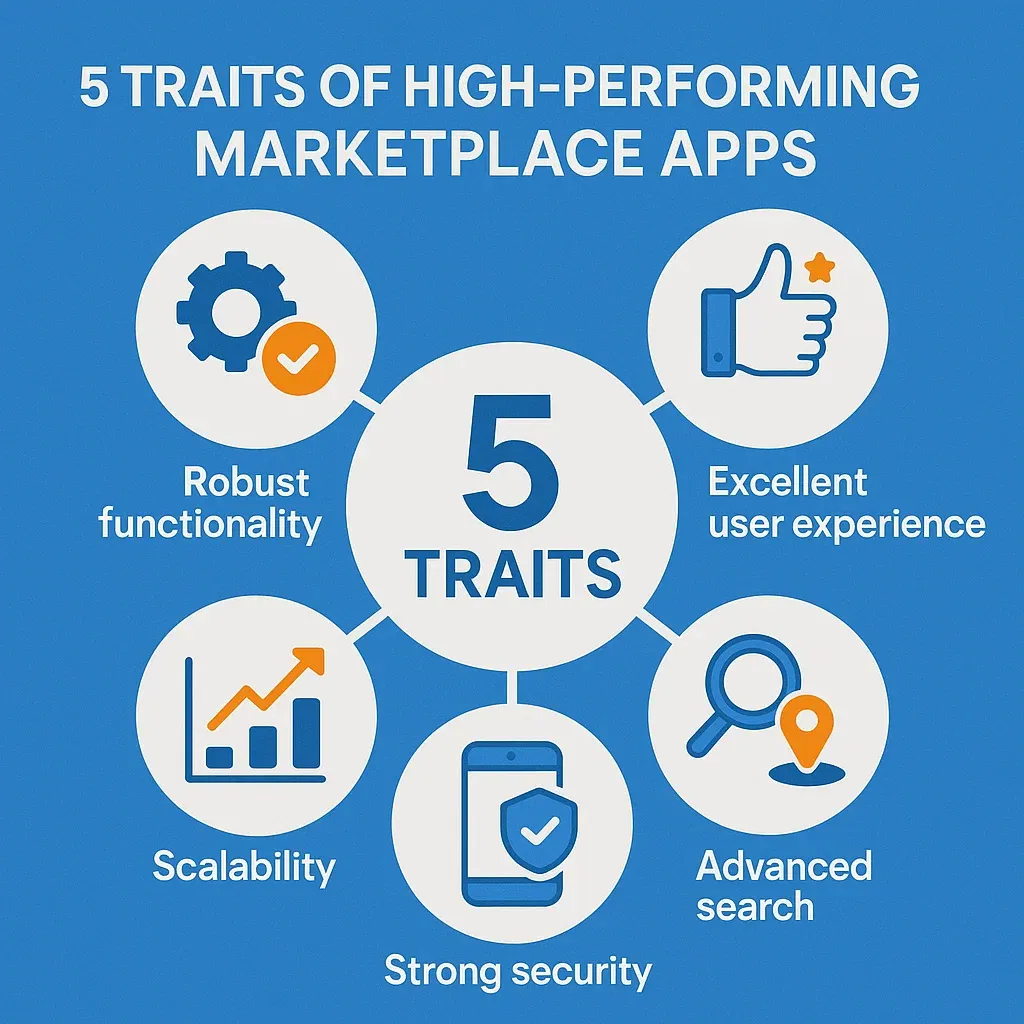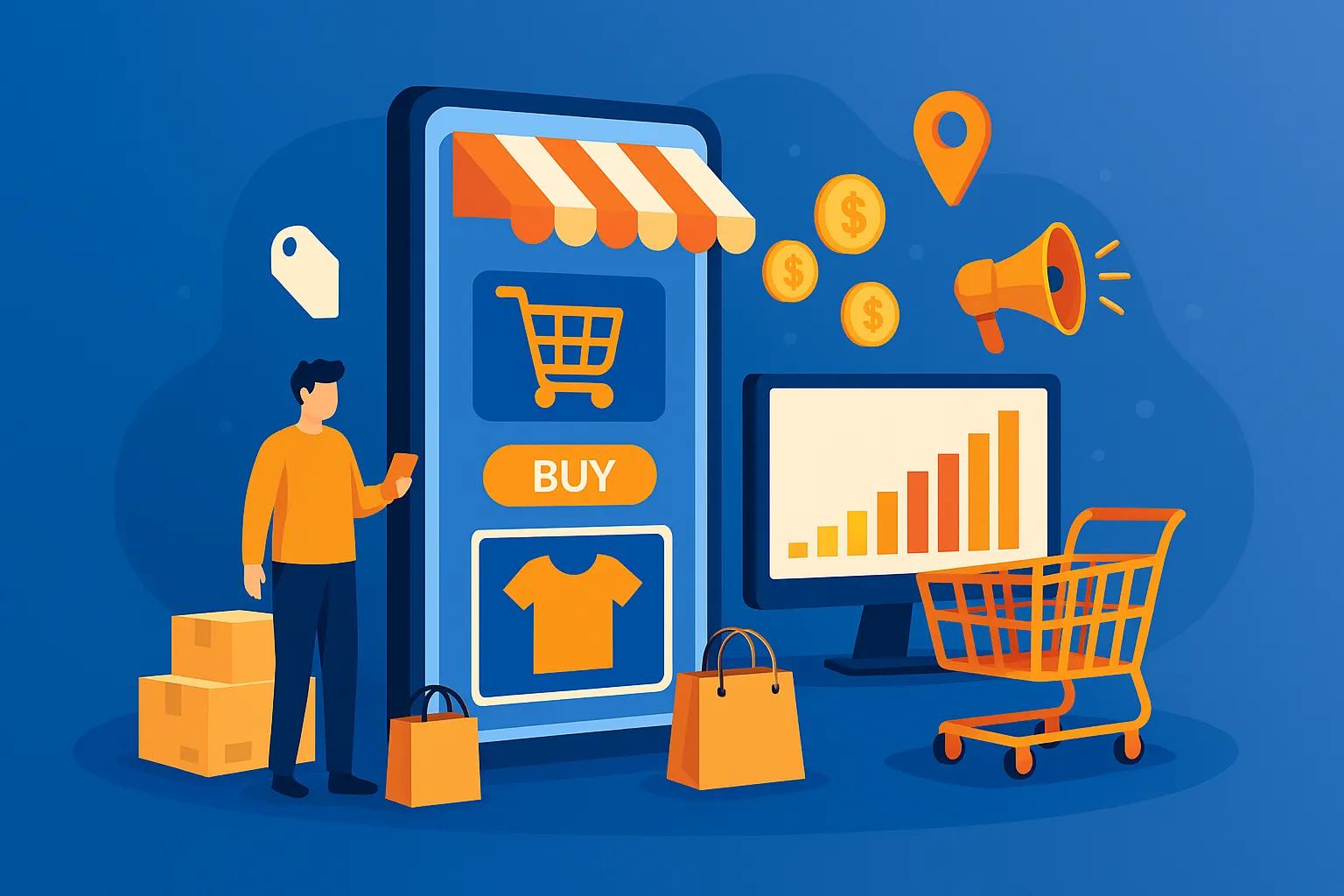The world of e-commerce has come a long way from simple online storefronts. In 2025, the most profitable e-commerce marketplace apps aren’t just about selling — they’re about creating ecosystems where buyers and sellers thrive, experiences are personalized, and transactions are frictionless.
With digital commerce surpassing $6.3 trillion globally and projected to grow even faster in the next few years, launching an e-commerce marketplace app has never been more promising. From niche marketplaces to AI-driven shopping platforms, the landscape is ripe with opportunity for startup founders, entrepreneurs, and digital agencies alike.

Read more: Complete Guide to Starting an E-commerce App Business
Why E-commerce Marketplace Apps Are a Hot Opportunity in 2025
The e-commerce marketplace model has proven to be one of the most scalable and profitable business models of the digital age. As we head deeper into 2025, the market conditions are exceptionally favorable for launching these types of platforms. Here’s why:
1. Explosive Market Growth
According to Statista, global e-commerce sales are expected to exceed $7 trillion by 2025. A significant portion of this growth is fueled by marketplace platforms, which account for over 60% of total online sales worldwide. Consumers increasingly prefer marketplaces due to product variety, price comparison, and streamlined buying experiences.
2. Shift in Consumer Behavior
Today’s digital shoppers value speed, convenience, and personalization. Marketplace apps that use AI and machine learning for product recommendations, real-time inventory updates, and one-click checkouts are thriving. Consumers also trust peer reviews and prefer platforms that offer social proof — another strength of marketplace models.
3. Funding Momentum for Marketplace Startups
Investors continue to back marketplace startups aggressively. In fact, CB Insights reports that funding for marketplace-based startups surged 35% year-over-year in 2024, with a focus on B2B marketplaces, hyperlocal delivery, and niche product categories.
4. Tech Enablers Lowering Barriers to Entry
With no-code tools, SaaS integrations, and clone app development solutions from platforms like Miracuves, startups can now launch sophisticated marketplace apps in a fraction of the time and cost it took a few years ago. This opens the door for more entrepreneurs to enter high-demand segments quickly.
5. Market Gaps and Emerging Niches
While giants like Amazon and eBay dominate broad retail categories, numerous niche marketplaces—from local artisans to refurbished electronics—are finding loyal audiences. These underserved verticals offer room for innovation and profit.
Quick Examples of Marketplace Success:
- StockX, a sneaker and apparel marketplace, was valued at over $3.8 billion by 2023.
- Faire, a B2B wholesale marketplace, doubled its revenue in 18 months.
- Farmdrop and other farm-to-table models are gaining traction due to consumer interest in ethical, local sourcing.
Top Profitable E-commerce Marketplace App Ideas to Launch in 2025
If you’re considering launching an e-commerce marketplace app in 2025, choosing the right niche is crucial. Below are 7 high-potential marketplace models that are not only profitable but also primed for disruption and innovation this year.
1. B2B Wholesale Marketplace
Connect manufacturers, wholesalers, and retailers in a streamlined platform for bulk purchasing.
Monetization Strategy:
Transaction fees, premium subscriptions for sellers, logistics and fulfillment services.
Why It Works in 2025:
The rise in global manufacturing, supply chain diversification, and SME digitization make B2B wholesale a hot opportunity.
2. Hyperlocal Delivery Marketplace
An app that connects local merchants (grocery, pharmacy, etc.) with nearby buyers and delivery agents.
Monetization Strategy:
Commission per order, featured listings for stores, delivery surcharges.
Why It Works in 2025:
Post-pandemic habits persist — consumers want everything delivered fast, especially within urban centers.
3. Rental Marketplace for Equipment or Spaces
A peer-to-peer platform where users can rent tools, vehicles, office spaces, or even event venues.
Monetization Strategy:
Listing fees, rental commissions, security deposit handling, premium insurance services.
Why It Works in 2025:
The “access over ownership” trend is strong among Gen Z and millennials, and sustainability-conscious users prefer renting.
4. Niche Fashion or Luxury Goods Marketplace
Sell curated fashion, pre-owned luxury items, or artisan-crafted products through a high-trust platform.
Monetization Strategy:
Commission on sales, seller verification fees, VIP buyer programs.
Why It Works in 2025:
Buyers crave authenticity, sustainability, and curation—especially in luxury and slow fashion.
5. Health & Wellness Marketplace
An all-in-one marketplace for booking health services, buying wellness products, or finding virtual fitness coaches.
Monetization Strategy:
Appointment booking fees, product sales, subscriptions for trainers or wellness experts.
Why It Works in 2025:
Post-COVID health consciousness is at an all-time high, and people want vetted, reviewed services.
6. Digital Product & Creator Marketplace
A platform for creators to sell eBooks, templates, courses, music, or stock photos.
Monetization Strategy:
Sale commissions, tiered creator plans, affiliate revenue sharing.
Why It Works in 2025:
The creator economy is projected to hit $500B by 2027. Micro-entrepreneurs want easy ways to monetize.
7. Eco-Friendly or Ethical Product Marketplace
A shopping app that features only environmentally friendly, ethically sourced, or fair-trade goods.
Monetization Strategy:
Transaction fees, brand partnership packages, eco-badge verification for products.
Why It Works in 2025:
A growing segment of Gen Z and millennial consumers is actively seeking purpose-driven, eco-conscious shopping experiences.
What Makes an App Profitable in the E-commerce Marketplace Niche?
Building a profitable e-commerce marketplace app is about more than just connecting buyers and sellers. The most successful platforms share key traits that allow them to scale quickly, retain users, and maximize lifetime value. Here’s what you should focus on:
1. Recurring Revenue Streams
The most profitable marketplace apps are built with recurring revenue in mind. This could include subscription plans for premium sellers, featured product placements, or loyalty memberships for users. These steady income sources smooth out revenue fluctuations and increase valuation appeal.
2. High User Retention
Marketplaces with tools that solve user problems repeatedly—such as fast delivery, trustworthy reviews, or personalized feeds—tend to build long-term relationships. Retention is key to reducing customer acquisition costs (CAC) and boosting ROI.
3. Low Overhead via Smart Automation
Automated logistics, AI-powered product matching, smart inventory syncs, and self-serve seller dashboards reduce staffing needs and operational friction. This keeps your cost-per-sale low, which translates to higher margins.
4. Strong User Acquisition Models
A profitable app must scale efficiently. Viral features like refer-a-friend programs, influencer integrations, and optimized SEO landing pages help you attract users without spending a fortune on ads.
5. Frictionless Monetization
Built-in payment gateways, escrow systems, and integrated wallets ensure you can monetize transactions securely and seamlessly. The easier it is to collect revenue, the better your bottom line.
6. Time-to-Market Advantage with Clone Solutions
Instead of reinventing the wheel, startups are increasingly turning to clone app development to accelerate their go-to-market strategy. Clone solutions—like those offered by Miracuves—come with core features already built-in, saving you months of development and significantly reducing your budget.
By customizing an existing clone solution, you can focus your resources on branding, marketing, and user experience—where the real competitive edge lies.
Cost to Build an E-commerce Marketplace App in 2025
The cost of building an e-commerce marketplace app in 2025 can vary widely depending on scope, technology, and approach. Whether you’re launching a minimalist MVP or a full-scale platform with real-time logistics and AI-powered features, understanding your options upfront will save both time and money.
Development Cost Breakdown
| Complexity Level | Estimated Cost Range |
| Basic MVP | $15,000 – $30,000 |
| Mid-tier App | $30,000 – $70,000 |
| Enterprise-grade App | $70,000 – $200,000+ |
Launch your E-Commerce Marketplace with Miracuves — Go Live in just 3-6 days! Complete solution starting from $2,800 to $3,500, including full source code, admin dashboard, and 60-day tech support.
Read more: Breaking Down the Cost of Developing an eCommerce Platform in 2025
Key Cost Factors:
- Platform Choice: iOS, Android, or both? Cross-platform development saves time and cost.
- Tech Stack: Using scalable backend solutions like Node.js or Laravel vs. native development.
- Feature Set: Essential features include user registration, product listing, payments, chat, ratings, etc. Advanced features like AI suggestions, real-time tracking, and dynamic pricing add to complexity.
- UI/UX Design: A sleek, intuitive interface boosts retention but also requires professional design time.
- Integrations: APIs for shipping, payments, analytics, or CRM systems add both value and cost.
Why Clone Solutions Make Financial Sense
Instead of starting from scratch, savvy entrepreneurs are opting for clone app development. These solutions are pre-built, customizable, and come with essential features already tested in the market.
With Miracuves clone solutions, you can:
- Cut development time by 70%
- Reduce overall build costs by up to 60%
- Launch faster with fewer technical risks
Whether it’s a StockX-style marketplace or a local delivery clone like Instacart, Miracuves provides white-label solutions tailored to your niche and growth strategy.
Tips for Founders to Launch a Successful E-commerce Marketplace App
Great ideas need great execution. If you’re a founder gearing up to launch an e-commerce marketplace app in 2025, these actionable strategies will give your product the best shot at success.
1. Start with an MVP-first Approach
Don’t try to build Amazon on day one. Focus on core features that validate your idea:
- Product listings
- Search & filters
- Buyer-seller messaging
- Secure payments
Launch quickly, gather feedback, and iterate. Your goal should be speed to learning, not feature perfection
2. Invest in UI/UX Design Early
A marketplace is only as good as its usability. An intuitive, mobile-friendly interface with clean navigation and consistent design builds trust—and trust drives transactions. Prioritize:
- Fast-loading screens
- Simple onboarding
- Clear CTAs (calls to action)
- Visual hierarchy for product listings
3. Validate Your Market Before Scaling
Use landing pages, waitlists, or social polls to test interest before development. Interview early users, run pilot campaigns, and track engagement.
By validating your niche, you reduce the risk of building something people don’t actually want.
4. Build with Scalability in Mind
Your backend infrastructure must scale with growth. Use cloud platforms like AWS or Firebase and adopt modular code practices to support user spikes and new features down the line.
Clone solutions from Miracuves come with a scalable backend architecture that grows with your user base—no re-platforming required.
5. Don’t Skip Post-Launch Marketing
Most apps fail not because of the product, but because of poor visibility. Invest in a pre-launch email list, influencer outreach, referral campaigns, and SEO content strategy.
And yes—optimize your app store presence (ASO) from day one.
Read more: Business Model for E-commerce Apps
Build powerful, scalable digital solutions with Miracuves’ Clone App Development Company services—crafted to replicate success models while tailoring features to your business needs.
Conclusion
As digital commerce continues to break records, launching an e-commerce marketplace app in 2025 is not just a smart move—it’s a strategic imperative for entrepreneurs ready to ride the next wave of innovation. From B2B wholesale to hyperlocal delivery and eco-friendly marketplaces, the opportunities are vast, and the appetite from both users and investors is undeniable.
What sets the winners apart is speed, execution, and adaptability. With clone app development solutions from Miracuves, you don’t have to build from scratch or risk months of trial and error. You can focus on your niche, your users, and your growth—while we take care of the technical heavy lifting.
At Miracuves, we help innovators launch high-performance app clones that are fast, scalable, and monetization-ready. Ready to turn your idea into reality? Let’s build together.
FAQs
Q:1 How much does it cost to build an e-commerce marketplace app?
Building an e-commerce marketplace app with Miracuves typically costs between $2,800 and $3,500, depending on your desired features, integrations, and design scope
Q:2 What features should a successful e-commerce marketplace app include?
Key features include user authentication, product listings, cart and checkout, secure payments, ratings/reviews, push notifications, and admin dashboards. Advanced features may include AI product suggestions, live order tracking, and seller analytics.
Q:3 Is it better to build from scratch or use a clone solution?
For speed, cost-efficiency, and market validation, clone solutions are the smarter choice—especially for first-time founders or startups with limited resources.
Q:4 How long does it take to launch a marketplace app?
A custom-built solution can take 6–12 months, while a clone-based app can go live in 4–8 weeks with the right customizations and integrations.
Q:5 Can I customize a clone app to match my brand?
Absolutely. Miracuves clone apps are fully white-label and customizable—from branding and UI to feature extensions and API integrations.
Q:6. How do I make my app stand out in a crowded market?
Choose a niche with unmet demand, focus on superior user experience, offer unique seller/buyer incentives, and ensure consistent post-launch marketing.
Related Articles:








